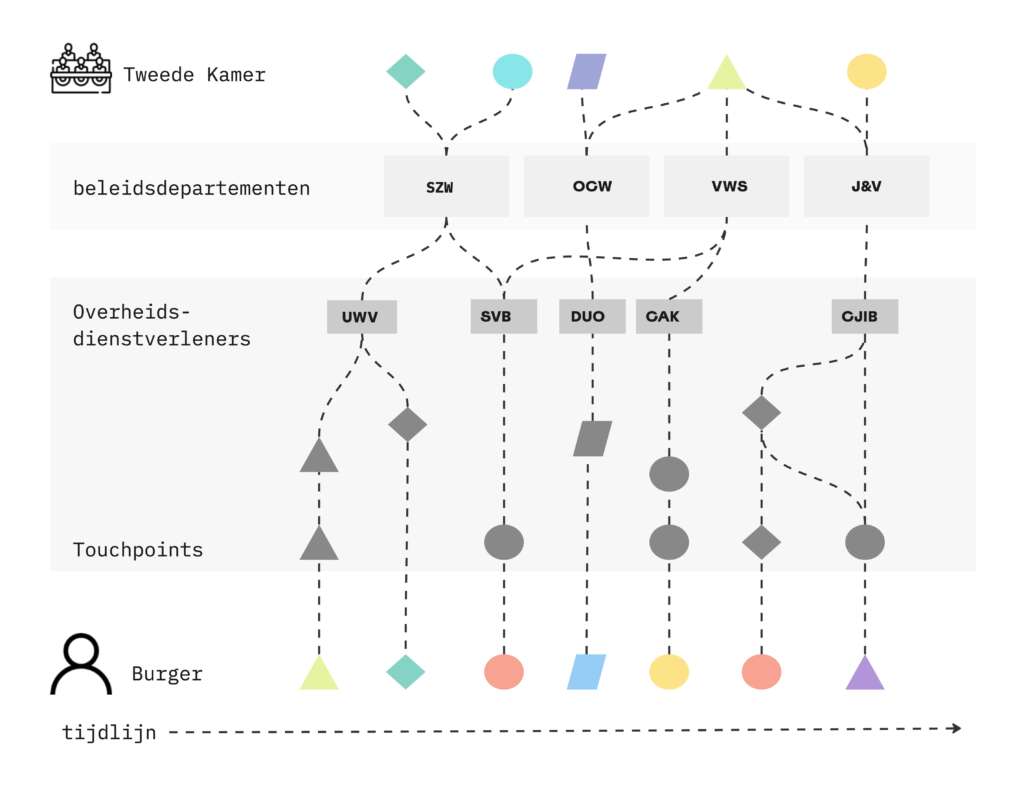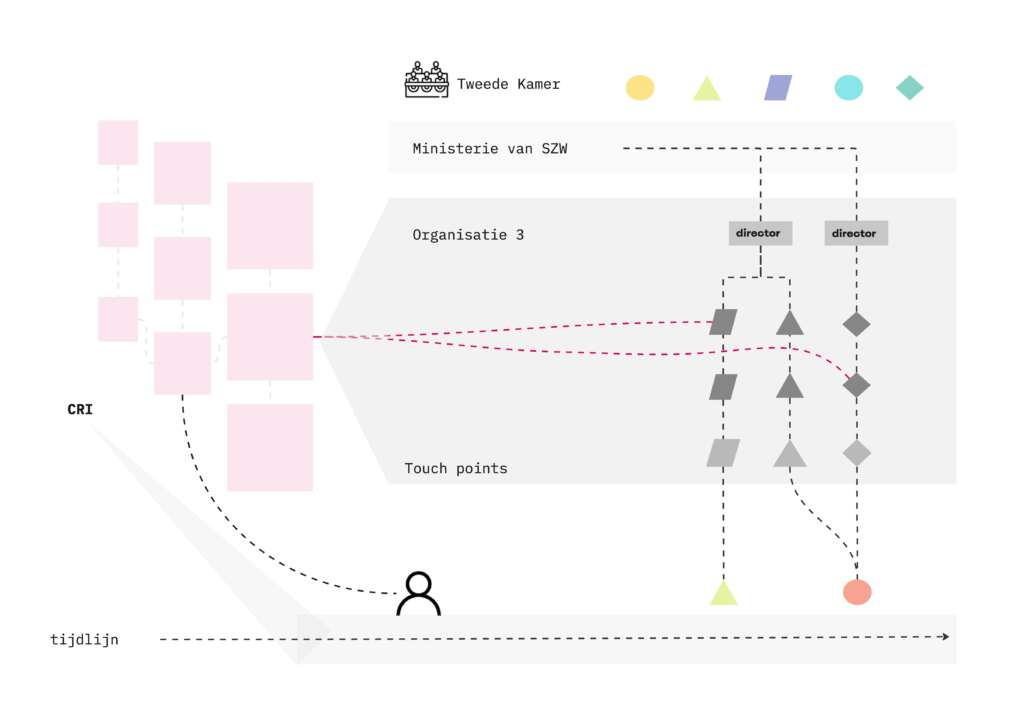I have been working on my doctoral research for more than a year and a half now, and am now working on the emperical part. In this blog, an update.
You’ll read about what I research, how I select the case study and which one it turned out to be. At the end a timeline of what the next time looks like. To stay in the travel theme, the route is now pretty much set.
Status quo of government services
I often show the figure below to explain how government organizations make services now, and thus what I want to change with my action research. It is a oversimplification of a month from my own relationship with the government.
I kept track of what I experienced with the government and what is involved in government organizations. It struck me that most organizations create and offer government services as if they have a 1-to-1 relationship with a citizen, but in practice that is not the case. Someone is constantly switching with different organizations to do all sorts of things. And the outcome of one service often impacts another. The question is whether the collective values we start with at the top still work out that way for the individual. The answer: well, no.
I wrote this blog about it that kicked off my doctoral research.

How can this be done differently? And how can we learn that as government organizations?
To examine how government organizations are growing in making services that are good for people, I think it is important to be as close to such a service as possible. I don’t want to explore it in theory or in an isolated innovation lab. No, as close as possible to practice, with my paws in the mud, in the middle of the status quo. That’s where it has to happen.
By zooming in on one government service, I can examine how the organizations involved are developing themselves in human-centered design. Since February, therefore, I have been following the Program on Clustering Government Collections (CRI). They are redesigning the status quo around debt issues. The motto: one citizen, one payoff capacity, one government collection. This video shows how they do it.
How do you select a case study?
Actually, I have only known for a few weeks that CRI and paying off debt is really going to be my case study. The first few weeks I spent at the program were spent exploring their practices and formulating case criteria from the literature. In qualitative research, it is important that you do that very well selectively and can substantiate it.
In the end, I arrived at the following criteria:
- The organization/team redesigns a government service, in this case “paying off your debt(s).
- This service is provided by multiple organizations (service bundling).
- This service is in the social domain and is typical of a national semi-digitized public service.
- There is room to adapt existing structures, roles and processes (and organizations).
- The service is redesigned based on human-centered design principles (or there is room for that).
- I may participate as an action researcher.
- The team goes “full circle”: society, politics, policy, implementation and citizens are involved.
- There is organizational and political will for change.
- The organization/team supports and participates in an open approach.
- There is funding for the case.
I must honestly confess that I also cheated a bit. After all, I already knew the program and intuitively knew: something interesting is happening here. So I made a list of why I really believed this should be the case. I then turned CRI everywhere into “the organization.
I ended up with the above list which was far more ambitious than I could have hoped for a government case I would have access to as a researcher. If I didn’t know this existed, I wouldn’t have known this was possible, so to speak. And then my supervisor said, “Well, Maike, in science you also have such a thing as ‘opportunity,’ so go for it!”
If I adjust the status quo to what that would look like in CRI logic, you get this artist impression:

I have kept a journal of observations for 22 weeks now. Along with a series of interviews, I will analyze them this summer. That sets the stage for a second cycle of research that I am shaping with the team beginning in September. Soon I will write a blog on how I have collected the data so far and what my analysis strategy is.
Focus!
In the first month of my PhD, my supervisor explained to me that you start with big plans that get smaller and smaller, until you only have a postage stamp left. That’s what you write your disseration on. He sent me this comic that illustrates it perfectly. Now at first I thought that was just annoying because of course I was going to solve all the government’s problems, granted.
Meanwhile, I do need focus, so in June I decided to devote my entire PhD to creating services around this theme: paying off a debt to the government.
This does not necessarily mean that I am going to explore this from the CRI program all the time. I prefer to look broadly from this program this year and switch perspectives sometime during 2025. Then I want to zoom in deeper on a government organization that is part of that broad debt approach. This is what that might look like schematically:

It does mean that I won’t switch to other services that the government also makes. My insights on how government can make good services will probably apply to those other services, but it gives me peace of mind to go into the summer with an increasingly concrete stamp in sight.
Are you also engaged in services around “paying off debt” and would like to share your insights with me? Yes, please! Send me a message at maike@klipklaar.nl. I will also share it with the CRI program team.
Timeline
So the research is taking shape. And I have to, because in October I will be halfway there – in terms of time. This is what my timeline looks like right now:

The picket stakes are in the ground. Nice!
Want to follow my research and not miss anything? Then subscribe to my monthly newsletter.
